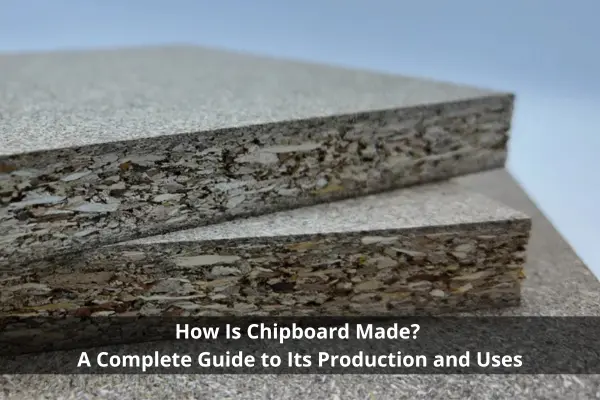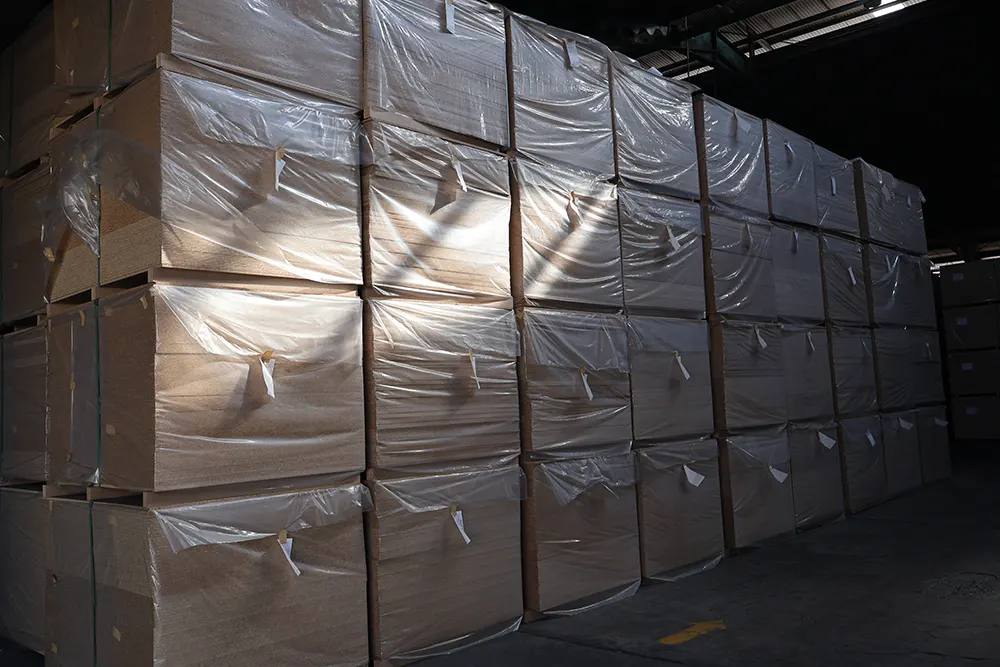Chipboard adalah salah satu produk kayu olahan yang paling banyak digunakan dalam industri mebel, konstruksi, dan pengemasan. Produk ini dihargai karena keterjangkauan, keserbagunaan, dan keberlanjutan. Tapi bagaimana chipboard dibuat? Memahami proses produksi akan membantu dalam menghargai manfaatnya dan bagaimana perbandingannya dengan bahan lain seperti MDF dan kayu lapis.
Artikel ini membahas proses langkah demi langkah pembuatan chipboard, bahan yang terlibat, dan aplikasi umumnya.
Daftar Isi
1. Apa Itu Chipboard?
Chipboard, juga dikenal sebagai partikel boardadalah produk kayu olahan yang terbuat dari serpihan kayu, serbuk gergaji, dan resin. Bahan-bahan ini dikompresi di bawah panas dan tekanan untuk membentuk panel yang kokoh. Sebagai alternatif yang hemat biaya untuk kayu solid, chipboard banyak digunakan dalam furnitur, lemari, dan desain interior.
Karakteristik Utama Papan Chip:
- ✔ Terbuat dari partikel kayu daur ulangmenjadikannya pilihan yang ramah lingkungan.
- ✔ Tersedia dalam berbagai pilihan nilai dan ketebalan untuk berbagai aplikasi.
- ✔ Bisa jadi dilaminasi dengan melamin untuk permukaan yang halus dan dekoratif.
- ✔ Lebih terjangkau daripada kayu lapis atau MDF, menjadikannya bahan yang hemat biaya.
2. Proses Langkah-demi-Langkah Pembuatan Chipboard
Produsen mengikuti beberapa tahapan utama untuk menghasilkan chipboard berkualitas tinggi.
1: Mengumpulkan dan Mempersiapkan Bahan Baku
- Pasokan industri penggergajian dan pertukangan kayu serpihan kayu, serbuk gergaji, dan partikel kayu daur ulang.
- Bahan-bahan tersebut melalui proses penyaringan untuk menghilangkan kotoran dan kontaminan logam.
2: Mengeringkan Partikel Kayu
- Pengering putar mengurangi kadar air hingga 5-7untuk memastikan ikatan yang lebih baik pada tahap selanjutnya.
3: Mencampur dengan Resin dan Perekat
- Mereka melapisi partikel kayu kering dengan bahan pengikat, biasanya resin urea-formaldehida.
- Resin bertindak sebagai lem, memungkinkan partikel-partikel terikat secara efektif.
4: Membentuk Panel Chipboard
- Sebuah mesin menyebar serpihan kayu berlapis resin menjadi beberapa lapisanmemastikan struktur yang seragam.
5: Menekan di Bawah Panas dan Tekanan Tinggi
- A pengepres panas hidrolik berlaku suhu dan tekanan tinggi (150-200°C) untuk merekatkan lapisan-lapisannya.
- Panas mengaktifkan resinyang menyebabkannya mengeras dan mengeras.
6: Pendinginan dan Pemotongan
- Panel yang ditekan menjadi dingin untuk menstabilkan strukturnya.
- Mesin pemotong memotong papan menjadi ukuran standar atau khusus.
7: Pengamplasan dan Penyelesaian Permukaan
- Panel chipboard melewati mesin pengamplasan untuk permukaan yang halus dan rata.
- Beberapa menjalani laminasi dengan melamin atau veneer untuk daya tahan ekstra.
8: Kontrol Kualitas dan Distribusi
- Pemeriksaan kualitas memastikan kekuatan, kepadatan, dan ketahanan terhadap kelembapan memenuhi standar industri.
- Mereka mengemas dan mengirimkan panel partikel board akhir untuk penggunaan komersial.
3. Berbagai Jenis Chipboard
Chipboard tersedia dalam berbagai jenis berdasarkan kepadatan, perawatan permukaan, dan ketahanan kelembaban.
1. Chipboard Standar ( Chipboard Mentah)
- Versi dasar, versi tanpa lapisan yang digunakan untuk bingkai furnitur, rak, dan kemasan.
- Membutuhkan finishing tambahan, seperti pengecatan atau laminasi.
2. Melamine Faced Chipboard (MFC)
- Fitur lapisan melamin dekoratif untuk menambah daya tahan dan estetika.
- Populer di lemari dapur, lemari pakaian, perabot kantor, dan rak.
3. Chipboard Tahan Kelembaban (MR Chipboard)
- Diobati dengan perekat tahan air untuk perlindungan yang lebih baik terhadap kelembapan.
- Cocok untuk meja rias kamar mandi, perabot dapur, dan substrat lantai.
4. Chipboard Tahan Api
- Berisi resin khusus yang memperlambat penyebaran api.
- Digunakan dalam bangunan umum, hotel, dan pintu tahan api.
Baca Juga:
Jenis Lantai Partikel Board: Panduan untuk Memilih Opsi Terbaik
4. Aplikasi Umum Partikel Board
Keterjangkauan dan kemampuan beradaptasinya membuat papan partikel berguna di berbagai industri:
- 🔹 Manufaktur Furnitur: Cocok untuk meja, lemari, lemari pakaian, dan rak.
- 🔹 Desain Interior: Sering digunakan untuk panel dinding, partisi, dan elemen dekoratif.
- 🔹 Industri Pengemasan: Ideal untuk kotak, palet, dan lapisan pelindung pengiriman tugas berat.
- 🔹 Konstruksi: Digunakan dalam lapisan bawah lantai, atap, dan papan insulasi.
Ini efektivitas biaya dan keberlanjutan menjadikan chipboard sebagai pilihan utama dalam proyek komersial dan residensial.
5. Partikel Board dari PT. Rimba Partikel Indonesia
PT. Rimba Partikel Indonesia is a produsen dan pemasok terkemuka Partikel Board berkualitas tinggiyang melayani produsen mebel, desainer interior, dan industri konstruksi. Mereka Partikel Board diproduksi dengan menggunakan partikel kayu kelas premium dan diproses dengan teknologi mutakhir untuk memastikan daya tahan, konsistensi, dan keberlanjutan.
Mereka menawarkan Partikel Board dalam berbagai ketebalan dan ukurancocok untuk produksi furnitur, rak, interior kantor, dan panel dekoratif. Komitmen mereka terhadap kualitas dan inovasi memastikan bahwa pelanggan menerima yang terbaik produk kayu olahan untuk proyek-proyek mereka.
📞 Hubungi Kami untuk informasi lebih lanjut tentang stok atau spesifikasi produk di admin-rpi@rimbapartikel.com atau WhatsApp +62 811-2679-094.
Kesimpulan
The proses pembuatan chipboard mengubah bahan kayu daur ulang menjadi serbaguna, hemat biaya, dan berkelanjutan produk. Melalui teknik pengeringan, pengepresan, dan finishingpapan partikel menjadi bahan tahan lama yang cocok untuk industri mebel, konstruksi, dan pengemasan.
Di antara berbagai jenis partikel board, Partikel Board dari PT. Rimba Partikel Indonesia adalah pilihan yang unggul karena kualitas tinggi, daya tahan, dan manufaktur presisi. Apakah Anda membutuhkan chipboard yang dipotong sesuai ukuran untuk furnitur, interior kantor, atau aplikasi industriPT. Rimba Partikel Indonesia menawarkan solusi terbaik untuk kebutuhan Anda.
🌿 Mencari Papan Partikel premium? Kontak PT. Rimba Partikel Indonesia untuk panel kayu dengan rekayasa terbaik yang disesuaikan dengan spesifikasi Anda! 🚀



